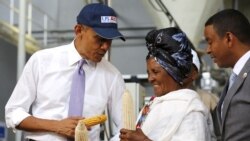In 2009, President Barack Obama announced that under his administration, the United States would prioritize alleviating global hunger, under-nutrition and poverty. At the time, the global economic recession and rising food prices were forcing ever more people into food insecurity. So, at the G-8 summit in L’Aquila, Italy that year, President Obama committed an initial $3.5 billion to fight global hunger and poverty.
Less than a year later, Feed the Future was born. It is an innovative initiative based on the premise that development efforts are most successful when the beneficiary countries determine their own food security needs and contribute to the effort. Led by the U.S. Agency for International Development, the initiative draws on 10 additional federal departments and agencies and investments from private sector partnerships.
Today it is clear that Feed the Future coupled with other innovative US Government food security initiatives are helping developing countries make substantial progress against hunger, poverty, and under-nutrition. Last year alone, Feed the Future reached nearly 19 million households through assistance or training and helped bring new tools and technologies, such as better seeds and fertilizers, to nearly 7 million farmers.
In fact, over the past five years in areas where Feed the Future works, the rate of childhood stunting, which indicates chronic malnutrition and leads to a host of developmental problems, has declined 9 percent in Ethiopia, 33 percent in Ghana, 25 percent in parts of Kenya, 21 percent in some areas of Cambodia, and 14.4 percent in areas of Bangladesh. Honduras and Bangladesh have seen a steep drop in poverty rates, and globally, more than 12 million children received nutrition interventions, such as vitamins and nutritional supplements, to help them grow and thrive.
Much of the improvement has come as a result of Feed the Future’s cooperation with a wide range of stakeholders to help smallholder farmers address the root causes of food insecurity and to increase economic opportunities.
"Through Feed the Future, the United States is partnering across borders and across sectors to unlock the transformative potential of agriculture,” said USAID Associate Administrator Eric Postel.
“From Asia to the Caribbean to Africa, Feed the Future is helping raise crop yields and incomes, reduce stunting and poverty, and improve child nutrition. Going forward, USAID and our partners will continue working to ensure everyone has the nutritious food they need to lead full, healthy lives."


















